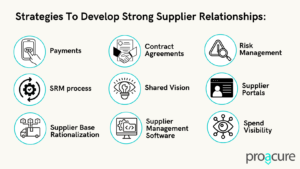Strategic Supplier Relationships in Procurement
Sanjay Agarwal and Hersh Agarwal, Proacure Research Team | January 8, 2021

Successful procurement operations require strong supplier relations. It enables in assessing a supplier and comprehending whether they contribute to the company’s success, thus facilitating quality supplier performance.
Introduction
A successful business is defined by successful relationships. Every organization has a chain of relationships being formed with suppliers and buyers, for products and services, adding value to the business and striving to make profits. Building strong relationships with suppliers can make the organization’s supply chain innovative and cost effective. Having in-depth knowledge of suppliers and creating a symbiotic relationship with them helps the organization benefit in terms of preferential pricing, dedicated services and beneficial contract terms.
Companies like Toyota are known for their supplier management strategies which have helped them develop long term, collaborative and close partnerships with key suppliers over decades. Toyota and Honda are one of the few companies who operate on the notion that they can create the foundations for partnerships only when they know about their vendors as much as the vendors know about themselves. They develop strategic potential suppliers, invest in R&D together and integrate transparency across operations. Such tactics have helped the company develop a reliable and efficient supplier base which not only helps in reducing maverick spending but also helps in value creation and consistent growth.
With the changing dynamics and technological innovations, procurement executives have predicted that the balance of power is changing. Creating harmonious relationships with vital suppliers is imperative. Understanding the supplier’s perspective, creating a strong foundation by focussing on determining core values and goals can help in forging a transparent, strategic bond with the suppliers.
Strategic Supplier Management
Effective supplier relationship management creates saving opportunities and ensures risk mitigation. The organization needs to foster the right behavior with the supplier base and ensure that a receptive and productive relationship is being formed. A strategic sourcing framework helps in creating a strong relationship with the supplier as it requires transparency, communication and an understanding that in order to have a competitive advantage along with solidifying the ROI, a company requires a pool of dependable vendors rather than transactional vendors.
The organizations need to recognize that strategic, dependable suppliers cannot be managed with traditional procurement practices which focus on price reductions. Strategic sourcing helps organizations gain a better understanding of the existing supplier relations and offers a practical perspective to enhance action planning.
The insights not only ensure better pricing opportunities but also help the organization become more reliant on suppliers in terms of innovative power, corporate social responsibility and security of supply.
Most organizations struggle to initiate, develop and manage supplier relationships. In order to create a collaborative relationship, both parties need to agree on a common ground to ensure a win-win situation.
Trends Influencing Supplier Relationships :
Supplier relationship management helps in developing a systematic approach to mutual growth and value creation among the organization and suppliers. The trends influencing supplier relationships today include:
Supply Chain Digitization
Integration of new technologies in the procurement process helps create transparency, enhances responsiveness and demolishes silos. It aids manual processing and creates a paperless and streamlined network for the organization.
Supply Risk Awareness
In order to mitigate supply risks, organizations focus on preferential supplier agreements which give the suppliers leverage. Price volatility/ fluctuations, cyber risks and risk induced by natural calamity & geopolitical risks can impact sourcing drastically. In such situations it becomes more important to have strong supplier relationships. By adopting the principles of supplier relationship management, the organization can take advantage of the fixed prices in the contracts and avoid the scaled increase in market prices.
Increasing Price Transparency
Digital procurement tools help increase price transparency across operations which ultimately aid negotiations. While negotiation practices traditionally help both the organization and suppliers to come to terms with each other’s objectives and requirements, technological advancements in procurement can also be used for reaching mutual terms with real time insights and predictive analysis.
Nearshoring
While digital procurement tools and automation has made collaborations with distant suppliers seamless, nearshoring and choosing local suppliers has shown better results while building strong supplier relationships which focus on value creation. Nearshoring enhances the supplier relationship management process by reducing delivery timelines, political and geographical risks, and overall costs by minimizing unnecessary expenditures like custom duties or other tariffs.
Operational Improvements
Long term relationships with suppliers allows flow of feedback and ideas for product development and inventory control
Challenges :
Strong supplier relationship development requires the procurement executives to make decisions regarding requirement specifications, switching suppliers, best prices, quality and delivery times. The trade-offs for such decisions are complex. The other main challenges faced during this process include:
Lack of synergy and direction in strategic partnership:
One of the most fundamental problems for businesses is to ensure that their key suppliers are going in the same direction as themselves and form the right synergy and partnership in the long term. The issue there is that the journey of a relationship from an outsider to the core competence is affected by issues of diverse business agendas.
On one hand, a business may want to keep its key supplier in business in order to secure the sources of supply in the long period of time. But on the other hand, it could just be about the short-term crucial gain through seasonal supply of a bottleneck item. Studies have shown that key partnerships are the source of competitive advantage and can provide a platform for important value differentiation.
Example:
Samsung is a critical supplier of Apple for its sharp and bright LCDs and memory chips. Apple uses these LCD screens for its iPad, iPod and iPhone. Both the parties are also involved in a lawsuit and this has meant that their mutual relationship is currently hitting rock bottom. As Samsung enters into the smartphone market, they stand differently in their strategy to that of Apple. Samsung sees itself, not just as a key supplier, but more importantly also as major competitors.
Cutting Samsung off would create precarious short-term problems for Apple as Samsung is perhaps an important part of the supplier-positioning. Due to this, Apple is investing in Sharp and Toshiba heavily as a replacement for Samsung LCDs. This example demonstrates the ineffectiveness of Apple to evaluate Samsung’s misdirection early on.
In this respect, it is more important than ever that a company and its suppliers align their strategy for success in the future.
Exploitation of Intellectual Property
According to multiple experts Intellectual property or IP rights are one of the most valuable assets for any enterprise. The argument is that when suppliers and companies are in business, they must ensure that they have clear ownership rights in order to avoid any breach in agreements.
As China leads the way in world exports, there are legitimate concerns that a minority of suppliers from China are involved in rights infringement. For example, in China, imitators known as Shanzhai companies account for about one-third of the share of the domestic market. Companies like ‘Nokia’ instead of Nokia and ‘Samsung’ instead of Samsung are operating in China. The global economic downturn is another trigger for future low quality counterfeits as Chinese factories could be tempted to shift their production capacity towards illicit manufacturing.
In developing relationships with suppliers, organizations need to be ready to encounter above-mentioned issues. For example, a company can question its own controls and mechanisms that are in place to detect and respond to supplier fraud.
Issues in managing a large portfolio of suppliers
Numerous studies highlight the importance of sourcing networks and relationships between firms to beat the global competition. Traditionally, supply chain management has been focusing on a particular key supplier. As the demand for flexibility has now increased, more suppliers meant further reduction of importance to any one specific supplier. Furthermore, modern day supplier selection from a pool of various options available can be a daunting process. Keeping this in mind, determining who is most important among them can be even more challenging. Thus, there are a few areas of concern in this context,
- A large portfolio of suppliers means that there are multiple requirements for each of the firm’s suppliers.
- Maintaining relationships with a large number of key suppliers can be costly and can possibly result in resentment for suppliers who are each other’s competitors.
- A large supplier base can make it harder for organizations to judge where to invest and hence, lose the focus in joint product development.
Example:
“Airbus” reduced their first-tier suppliers from 3000 to 500 as part of their major restructuring program Power 8. Also, Thales, a major supplier to European aerospace, reduced their key suppliers from 3000 to 1100 in three years following 2004.
The advantages of working with fewer key suppliers are major drivers of restructuring in supply chains for many companies. Firstly, there is cost; placing a greater importance on a smaller number of key suppliers allows companies to gain more influence over vendors. Secondly, if there is a focus on selected suppliers, the total cost of ownership for a firm can be reduced.
Buyer-Supplier Power Imbalance & Strategic Collaboration
When dominant players seek to protect their own interest at the expense of others in a relationship or a contract, it leads to power asymmetry. This Asymmetry of power can be further complicated by risk and uncertainty.
In the film industry, for example, the two key players are film studios and talent. Film studios keep referring to large corporations like Warner Brothers, Sony Entertainment and talent refers to people of specialized value, for instance, actors. Studios buy from the talent and hope to turn their movies into successful box office hits.
Researchers argue that a major challenge for the film industry is uncertainty. Demand is key for films to be successful. Studios understand this and either insure themselves or try to make sense of market variations. As none of these strategies are sustainable on their own, they enter into relationships with the collaborating supplier of talent who take full advantage of the situation. This turns the relationship between the buyers of talent and the talent adversary. So, studios end up taking all the risk and upfront cost, whereas the talent reaps a major chunk of the benefits if the film is a success. Similar imbalances of power are visible in all fields of business.
Communication and Transparency
For a strong buyer and supplier relationship, communication is of paramount importance. If a supplier doesn’t understand the company’s strategic goals it won’t be able to fulfill the needs and requirements and thus give poor results. Maintaining good contact with the suppliers can help the organization in a big way. However, collaborative buyer seller relationships aren’t always easy to create and maintain. Between the procurement department and the buyers and sellers, all of them will need to find common ground for the perfect methods of communication. A lot of times, the non-transparency of the supplier’s process creates communication gaps in the company-supplier relationship. If the buyer and seller relationship isn’t open and transparent, this can lead to problematic misunderstanding of business needs. If the correct information isn’t shared between each party, this can mean that crucial business opportunities could be missed.
Strategies To Develop Strong Supplier Relationships

A strong supplier relationship ensures consistent and collaborative growth with improving supplier deliverables, and creating value.
- Payments
Fulfillment of payments on time is a tremendously important element of an effective SRM (supplier relationship management). This is an extremely important step in ensuring that the company’s valuable suppliers are not lost. Timely payments also help companies to establish and firm their credibility and reliability as a buyer to their suppliers. Just like companies like to receive prompt and timely delivery of goods and services from the suppliers, the suppliers expect timely payments.
In scenarios where companies are unable to make payment on the date agreed, then they must keep the supplier in the loop and inform the supplier as soon as possible with the details of the timings and the dates on which they can anticipate the payment.
- Contract Agreements
Supplier relationship management is extremely vital and absolutely non-negotiable in the case of companies that buy from a vendor on a regular basis. One should start with listing out what both parties expect from the partnership such as item or service description, price and communications.
The parties must discuss clear terms and goals, contract compliance and audits, compliance metrics including rating methods, scorecards and feedback before sealing the deal.
The complexity of this document depends on the business requirements as a well-documented supplier relationship agreement reduces the possibility of confusion or disputes and paves the way for better supplier relationship management. Detailed insights into the historical spend patterns along with the clarity about the terms agreed can help the organization enforce contract compliance and in some cases, substantially reduce off contract spending by the suppliers.
- Risk Management
One of the most important factors in supplier relationship management is to evaluate and estimate the risks which are involved, especially if the company has a complicated supply chain. The way this can be done is by asking the supplier for references, examples of their previous work, years of expertise in the particular business, and how they deal with a crisis. This assessment largely helps businesses understand the credibility of their suppliers.
It is also crucial to ask critical questions such as – Are they competitively priced? Do they have the right experience? Do they have the capability to deal with the various orders? Are they financially stable? All these questions allow businesses to pick the particular type of supplier they want. For example, the supplier selected is not the cheapest but guarantees 100% on-time delivery with a money back offering; businesses can live with that because if the vendor lets the company down then their whole supply chain may be at risk, then it can affect the company’s ability to deliver to the customers.
- SRM process
According to a Global SRM Research Report, people and their soft skills are the core of Supplier Relationship Management, so whether you need an invested Supplier Relationship Manager, or even if it’s only a part of someone’s role, having people in your organization who are responsible for the process is highly important. It is advisable to create a documented process that will help your team through the management and administration of suppliers. In a large organization such things include(but are not limited to) flowcharts, SOPs, Policy Documents and agreements.
The Global SRM Research Report also states that 37% of supplier relationship specialists have a higher level of engagement from suppliers when they engage with them in this way, and this established a stronger bond with the vendor, where both parties have a huge interest in maximizing their goals and outcomes, and in turn helps your business grow and reduce unrequired business hassles that can be time consuming for other business drivers.
- Shared Vision
Strategic partnership ensures that both the organization and the supplier approach their joint objectives with alignment at the vision and strategy level. With consistent evaluations, a clear set of standardized metrics and business reviews being an integral part of the framework, both parties are aware and feel responsible for the joint vision and hence work towards it constructively.
- Supplier Base Rationalization
Supplier base rationalization refers to the process of reducing the number of active suppliers to streamline the organization’s spend and drive better value from supplier relationships. Identifying multiple vendors providing items across a particular subcategory can help reduce supplier fragmentation. Supplier rationalization is focused on allocating the right amount of suppliers, with the correct kind of performance and price to support an efficient sourcing strategy. Traditionally, supply base rationalization and spend management both focus on supply base reduction, cutting the supply base to the absolute minimum to encourage competition and convert that competition to the company’s advantage at the negotiation table through fewer suppliers providing larger savings.
But as more and more organizations discover the potential of digital transformation and artificial-intelligence technologies such as process automation and deep data analytics, many procurement teams are looking to get insights from their data to optimize their supply chains for more than cost savings. The bottom line remains a priority.
Although, the current 21st century rationalization process heavily prioritizes creation of value as well as multiple savings opportunities. It uses supplier relationship management to consolidate the supply base using a model built around the core of key sellers supported by an indefinite number of additional vendors who can be asked to address specific needs when required.
- Supplier Management Software
Nowadays, businesses can also take one step further and install an advanced software.A good supplier management software helps companies keep track of information about their suppliers in one place (Supplier Data Management).It is useful in creating, processing, and tracking purchase orders with the suppliers and for timely payment to the supplies through the AP system.
- Supplier Portals
A supplier portal is an internet-based system for managing and connecting with third-party goods/service providers. It’s a secure management solution used by businesses that collaborate with various vendors. They assist in supplier onboarding, supply chain management , invoice and payment inquiries, etc. through 24×7 real time data access.
- Spend Visibility
Spend analysis can play a vital role in helping supply managers not just improve initial negotiation of vendor contracts, but also maintain positive and mutually beneficial relationships with these suppliers over time.
Spend analytics allows the organization to optimize the external spend with suppliers which approximately amounts to around 40-80% of the organization’s total expenditure. Understanding and analyzing spend patterns helps organizations identify suppliers to build strategic relationships with.
Better visibility boosts buyer leverage and helps the organization collaborate and engage with strategic suppliers. Using spend analytics tools the organization can leverage the insights into the creation of efficient sourcing strategies to have a better cost to value alignment with potential suppliers. Monitoring KPIs and performing spend analysis help in the organization’s overall strategy which enhances overall supplier relationships.
Conclusion
Strong supplier relationships are key to successful procurement operations. Communication, transparency, mutual respect and fair contractual agreement act as a foundation in supplier relationships.
Strategic sourcing helps in building long term strong supplier relationships which engage in continuous improvements in the procurement process. The framework achieved this strong relationship with suppliers through product development and integration of effective KPIs, SLA’s and contractual performance. Such strategic partnerships provide more value in the long term.
Proacure is a procurement technology & data-science organization based in the San Francisco Bay Area. Our ‘Koreografy’ model leverages multiple frameworks like congruence of different data sets, fusion of digital, analytics and business processes, and synchronous collaboration between various stakeholders. The model enables 100% Spend Visibility with prescriptive actionable insights to transform Strategic Sourcing and help realize untapped value in the Supplier and Tail Spend. Proacure’s deliverables include cost savings of 7-30%, a 20%+ increase in EBITDA, cash flow optimization, and reduced supply-chain disruption.
Related Articles




